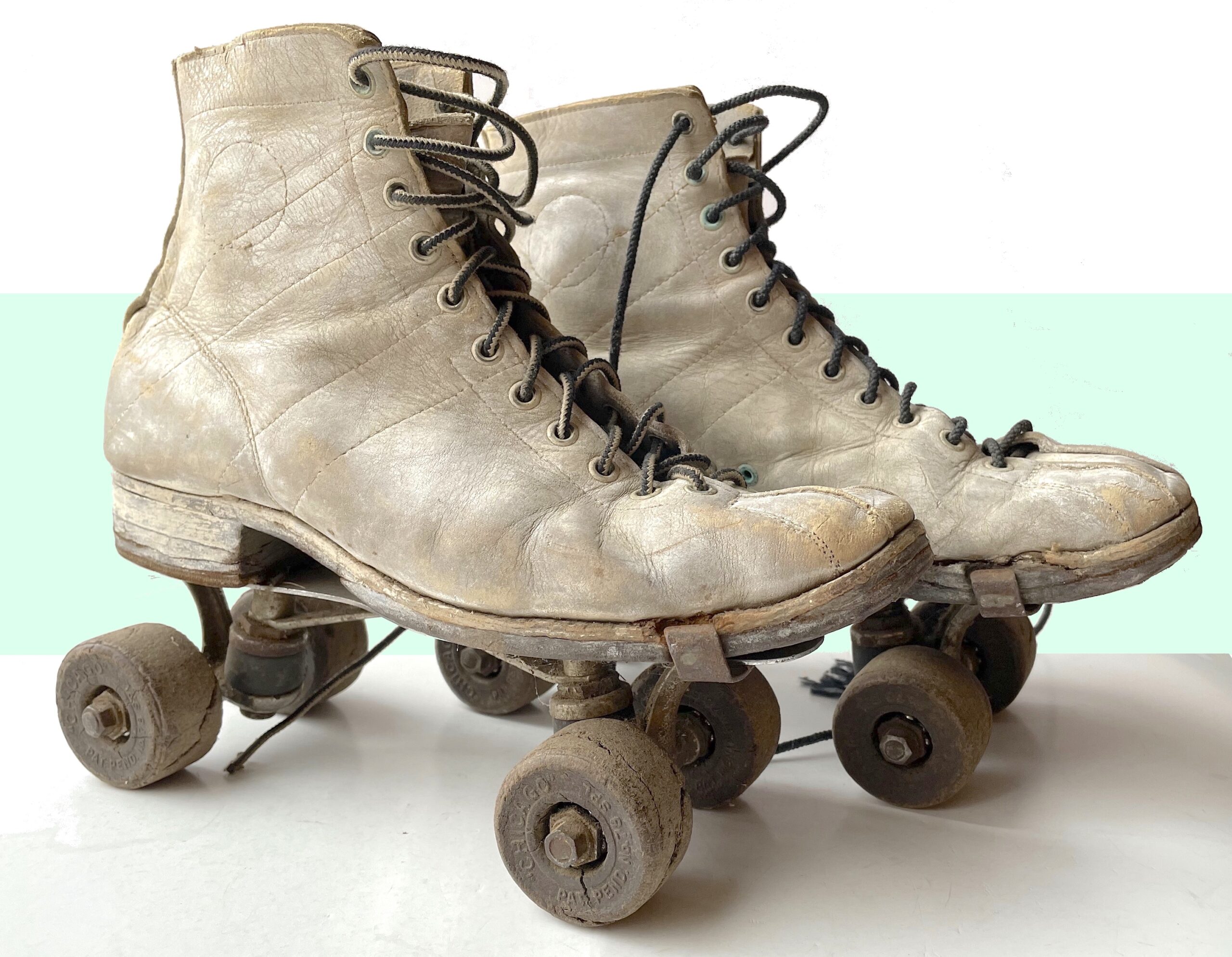
Museum Artifacts: Chicago Roller Skates w/ White Boots and No. 78 SPL Wheels (c. 1939), Chicago Roller Skates w/ Brown Boots (c. 1945), and Chicago Skates without boots (c. 1920s)
Made By: Chicago Roller Skate Company, 4458 W. Lake St., Chicago, IL [West Garfield Park]
“They used to call him ‘Slow-Poke’ when he had those old-fashioned, slow, hard-rolling skates. But, Oh Boy! On ‘Chicagos’ he whizzes to the lead like a flash. ‘Chicagos,’ the Choice of Champions, have established more World’s Records than all others, yet cost less in the long run. They’re the skates for Y-O-U! Ask Dad for a pair today!” —Advertisement for the Chicago Roller Skate Company’s “Flying Scout” skates, 1931
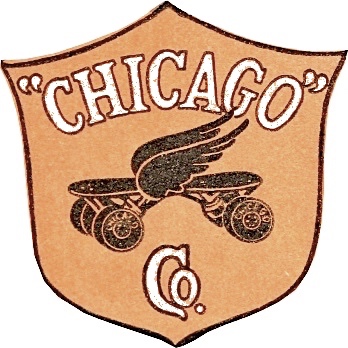 For much of the 20th century, the Chicago Roller Skate Company was headquartered just a few miles south of another reputable, wheel-based sporting good manufacturer—the Schwinn Bicycle Co.—and in many ways, the stories of the two businesses would unfold in the same fashion.
For much of the 20th century, the Chicago Roller Skate Company was headquartered just a few miles south of another reputable, wheel-based sporting good manufacturer—the Schwinn Bicycle Co.—and in many ways, the stories of the two businesses would unfold in the same fashion.
Once the standard bearers of their industries and the preferred choice of every kid looking for cool, independent modes of transport, these brands were ultimately pulled under by the cruel current of a changing culture. Yes, cheap foreign imports were a big factor, but strategic missteps also played their role. Much as Schwinn had failed to foresee the rise of the mountain bike in the 1980s, the Chicago Roller Skate Co. underestimated the phenomenons of inline skating and skateboarding—despite having an inside track on both markets way back in the 1960s.
It’s a bit rude to start the story there, though.
For the vast majority of its history, the Chicago Roller Skate Co. was the superior skate-maker in the country because of its business savvy and instincts for innovation. The two sets of rusty metal skates in our museum collection—both dating back before World War II—were groundbreaking for their time, offering patented features such as “an interlocking and unbendable Channel Arch, Oversize Ball Bearings, and Oscillating Trucks with Shock Absorbers.”
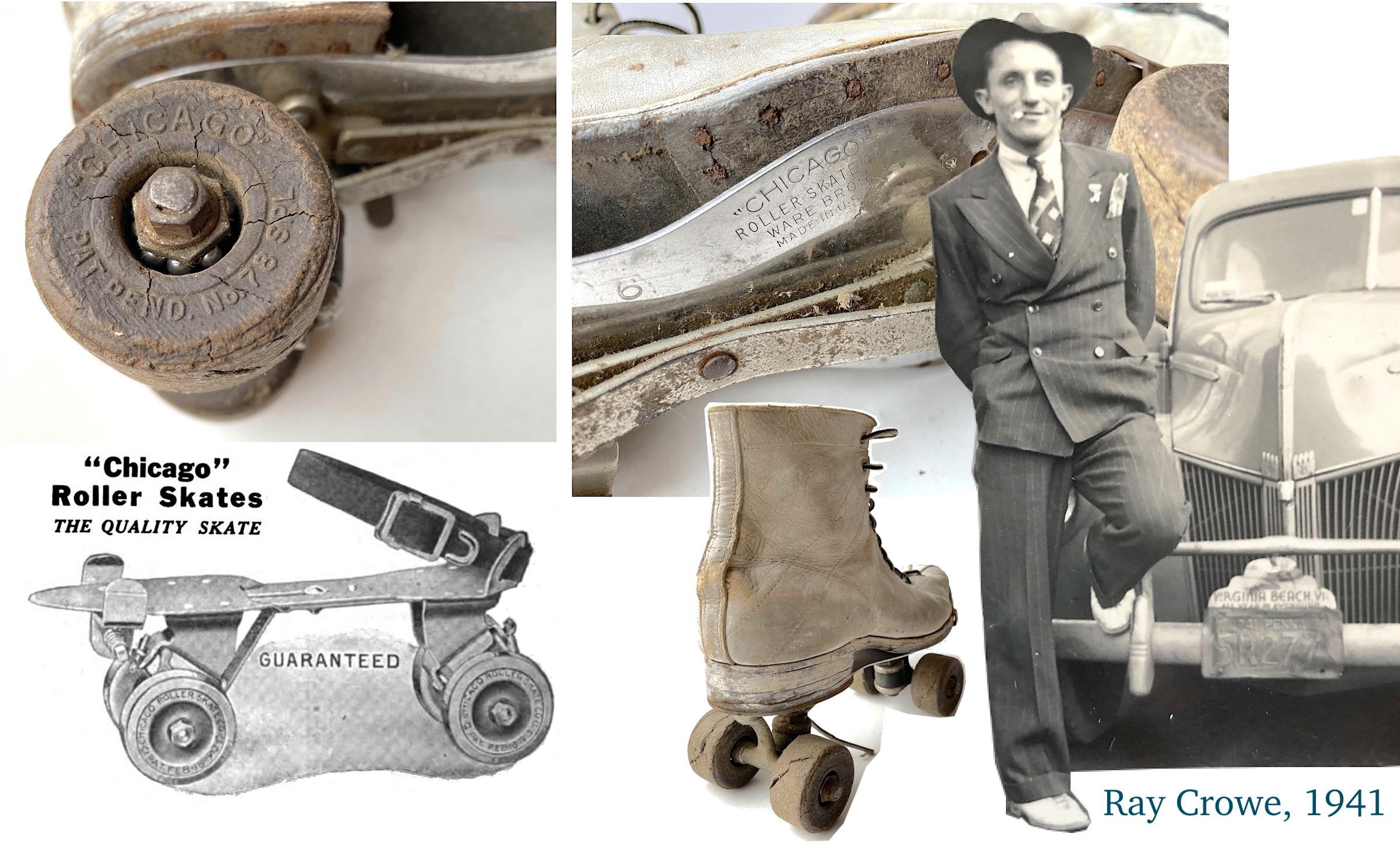
[Avid roller skater Ray Crowe, pictured above at the age of 18 in 1941, wore his white Chicago Roller Skates in the years before WWII. They now reside in our museum collection, donated by his daughter Carol Weitzman]
The rolling portion of the wheels—often made from maple in early models—features a new fiber/plastic construction in the No. 78 SPL design (pat. 1942) pictured above. These specific skates were used in the late 1930s and early ’40s by Ray Crowe (1921-2003), the resident “skate master” at his local rink in Drakesburg, Ohio. They were donated to the museum in 2021 by his daughter, Carol Crowe Weitzman.
Built at efficient cost and sold en masse with the average family in mind, “Chicago” skates rode the ebb and flow of roller skating’s general popularity within the culture, from the first big heyday of roller rinks in the 192os to their disco revival in the ’70s. Through that entire period, the Chicago Roller Skate Co. remained an independent, family-run business in its namesake city.
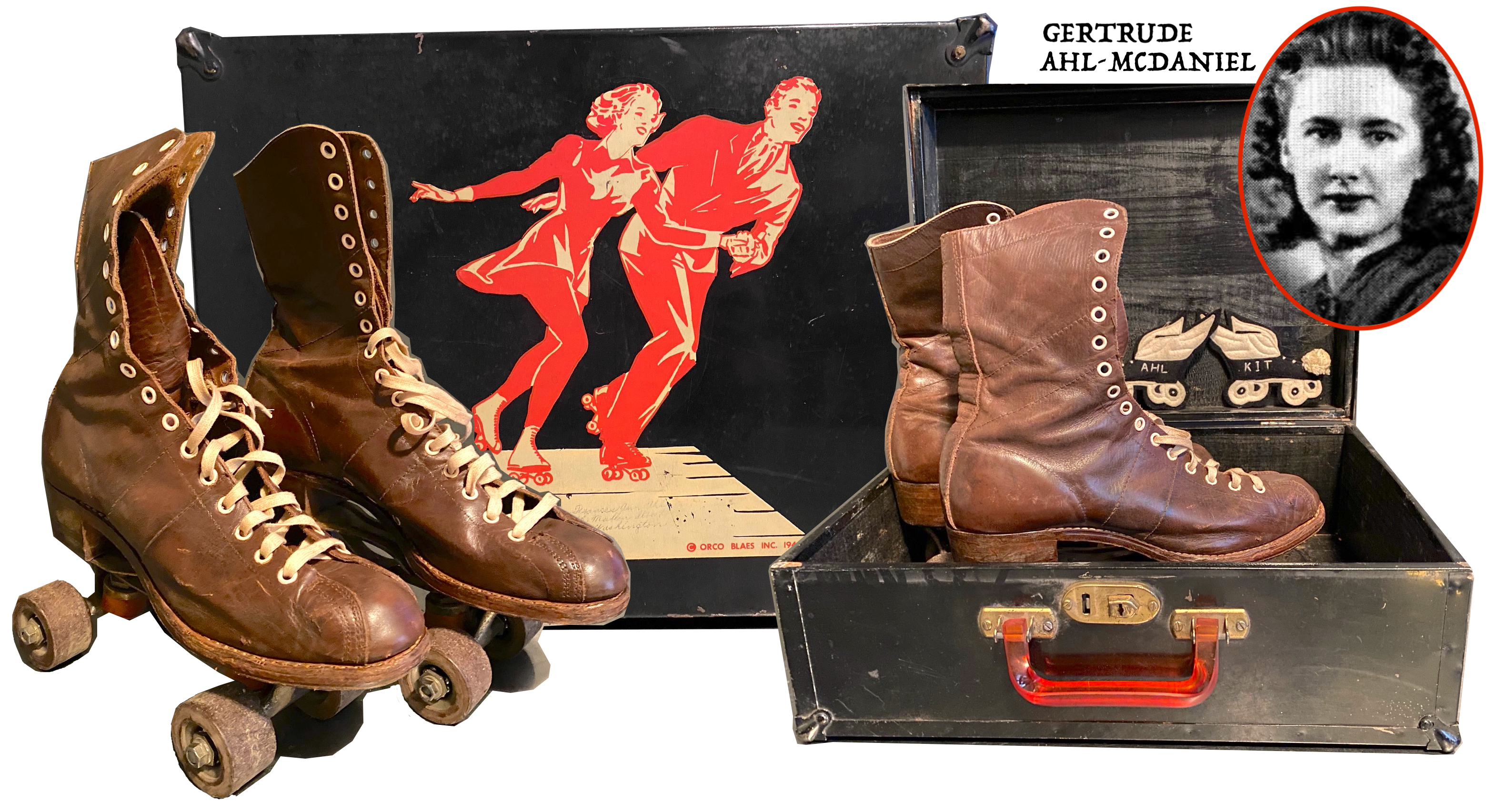
[Another pair of Chicago skates and a carrying case from our collection. These were donated by Elaine Sorensen and were owned by her mother Gertrude Ahl-McDaniel during her days as a young skater in Tacoma, Washington, in the 1940s.]
History of the Chicago Roller Skate Co., Part I: Wheels of Fortune
The Chicago Roller Skate Company was founded (sort of) in 1905 by brothers Ralph and Walter Ware, sons of a successful Chicago real estate man, Elisha C. Ware. Technically speaking, the business already existed before the Wares came along, but it was essentially just a skate shop in name only, with no inventory in stock. In this sense, it was a low risk / high reward investment.
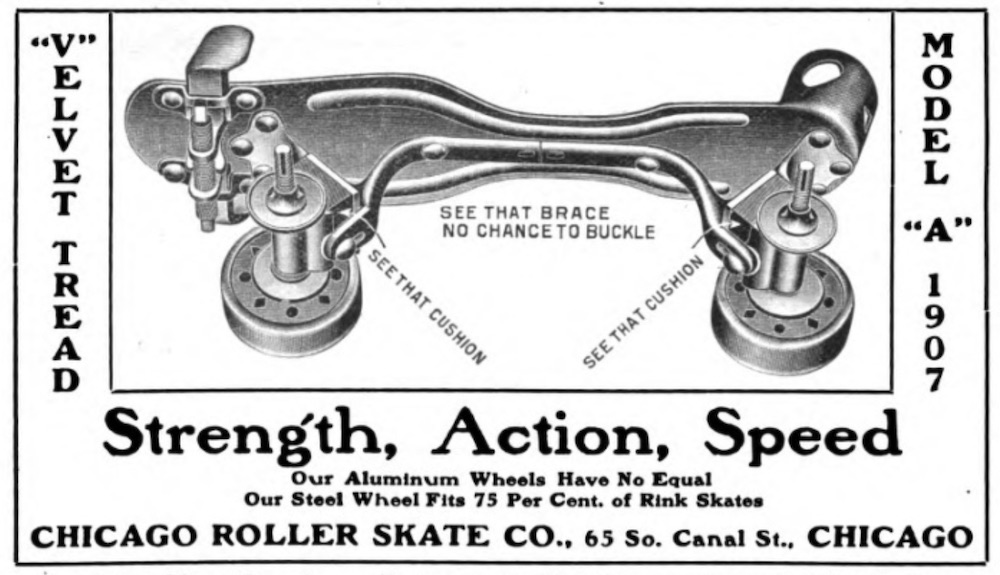
The young greenhorn Ware Bros., who were both in their early 20s, had the financial backing of their father at the outset, but when 63 year-old Elisha Ware died unexpectedly in his office of heat stroke in 1909, a third son—Robert Ware—returned to Chicago from Idaho to join his brothers and bring his marketing and shipping experience to the skate enterprise.
In a 1985 interview with the National Museum of Roller Skating, Robert’s son, Robert Ware Jr., retold one of the more famous (possibly apocryphal) tales from the company’s early days. “They produced a three-wheel skate which they tried to sell to the local roller rinks,” he said. “One of the top rink men [Paddy Harmon, builder of the Chicago Stadium] so disliked the skate that he threw it at Walter, who dodged and fled.”
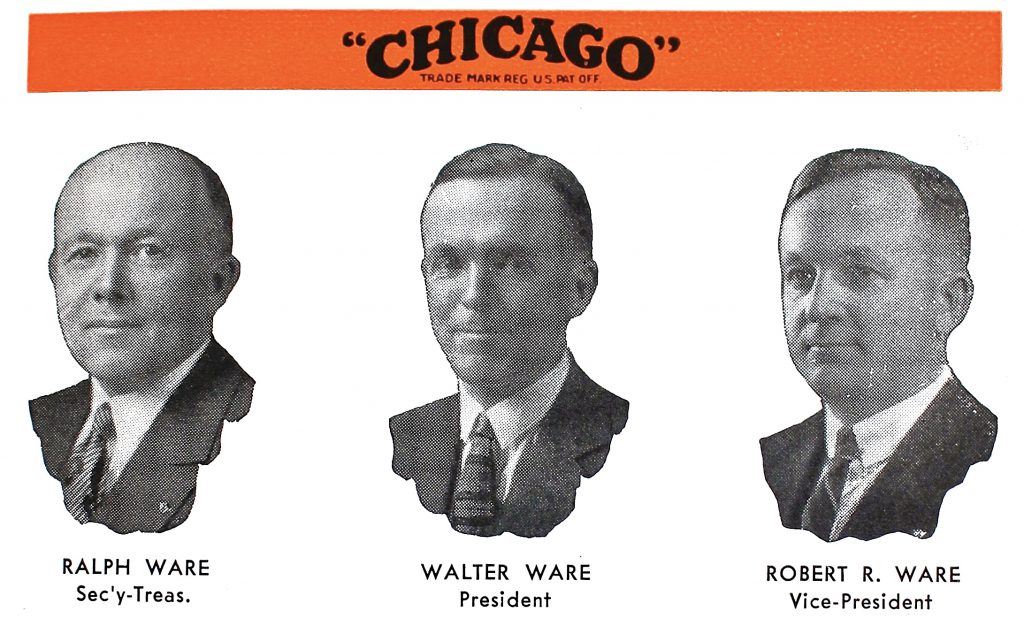
[The Brothers Ware, circa 1930]
Only briefly demoralized, the Wares reconvened and dumped their weird three-wheel skate in favor of the four-wheel 1907 “Model-A,” which came with a steel footplate, ball bearings, and a much more welcoming response from the rink runners.
That same year, the Ware Bros. had a team of 14 workers in a small loft space at 65 S. Canal Street. By 1910, the staff had grown to 35, and a new space was acquired inside the Eagle Building at 1123 W. Washington Blvd. (a building that is still standing more than a century later, as seen below).
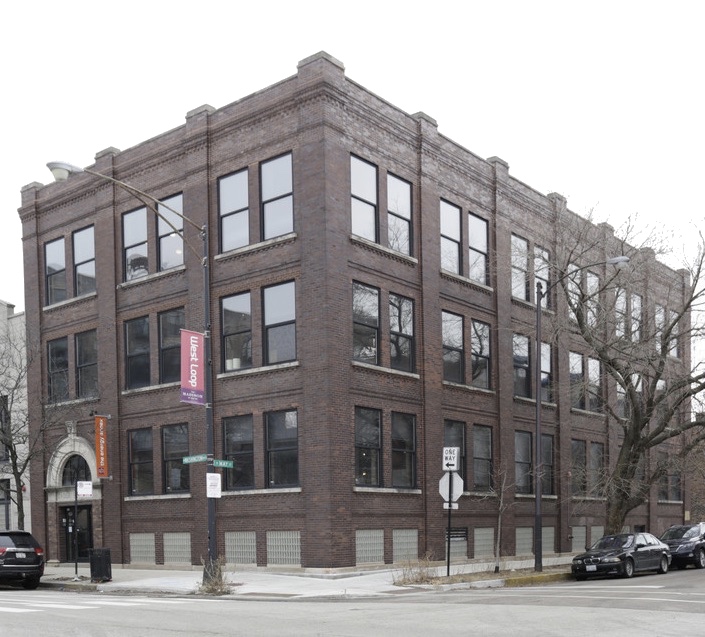 Chicago Roller Skate made sports and racing skates, but since outdoor skating was still a rarity, the company regularly produced metal wheels with smooth maple wood rollers, to match the gym flooring of the city’s various casual skate halls and roller rinks.
Chicago Roller Skate made sports and racing skates, but since outdoor skating was still a rarity, the company regularly produced metal wheels with smooth maple wood rollers, to match the gym flooring of the city’s various casual skate halls and roller rinks.
Young folks often went to these venues after school to skate-dance along to live pipe organ music—which might sound a bit bizarre, but rest assured, this was straight up rebellious behavior for the average teen in the age of Woodrow Wilson.
The tradition of raging hormones on wheels would change little as the music gradually evolved into big band jazz, then rock n’ roll, then disco, etc.
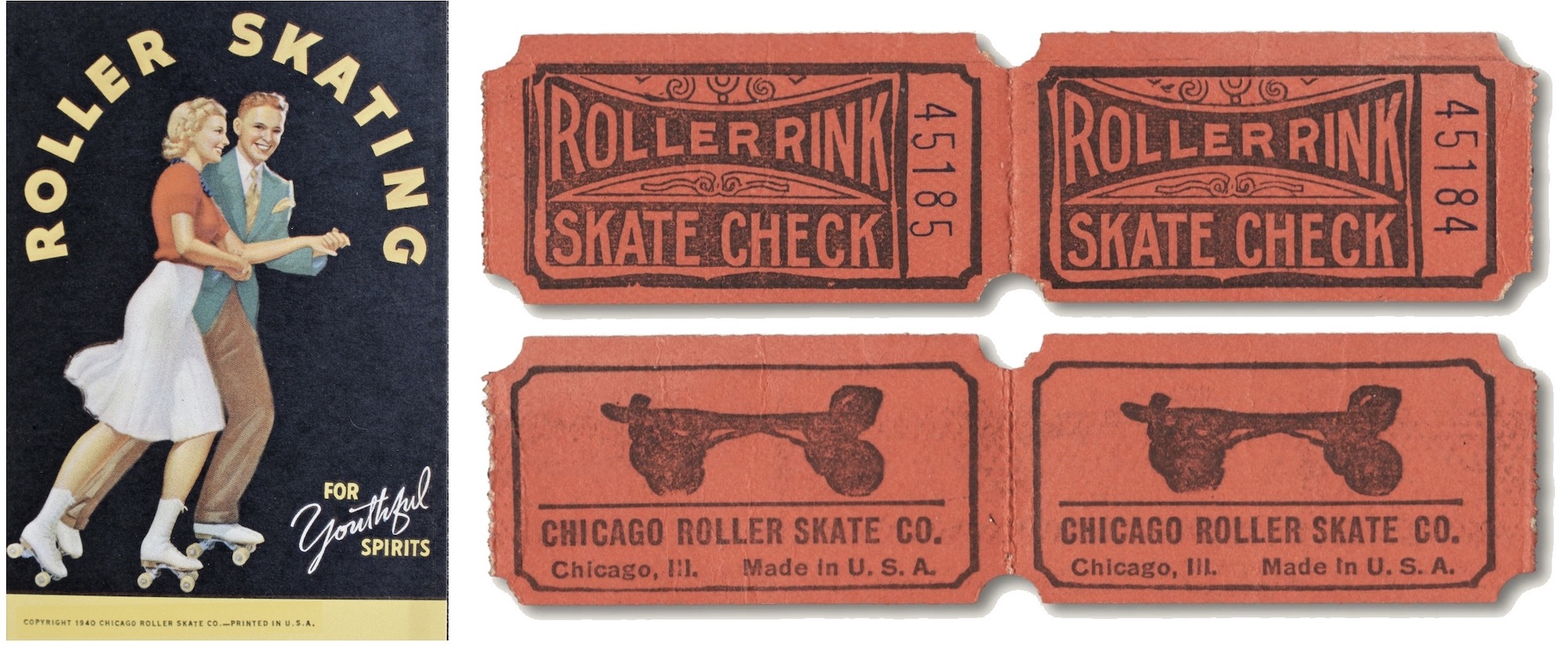
II. Rolling in the Deep
After a hiatus during World War I in which the CRS plant switched to manufacturing propeller bolts for the military, skate-making resumed in 1918, and a year later, a new $75,000, 40,000 sq. ft. plant was built at 4408 West Lake Street in West Garfield Park. While this factory would be modernized and expanded in 1939, the location would essentially remain the company’s headquarters for the remainder of its days in the city.
“I can remember, as a kid, it was a great place to play,” Robert Ware Jr. later recalled, “hooking up huge packing crate lids with the overhead trolleys which connected the different departments. I had great fun with my own thrill ride during non-working hours. Also I liked to play with the giant tubs of ball bearings, and play hide and seek around the huge cartons of roller skates.”
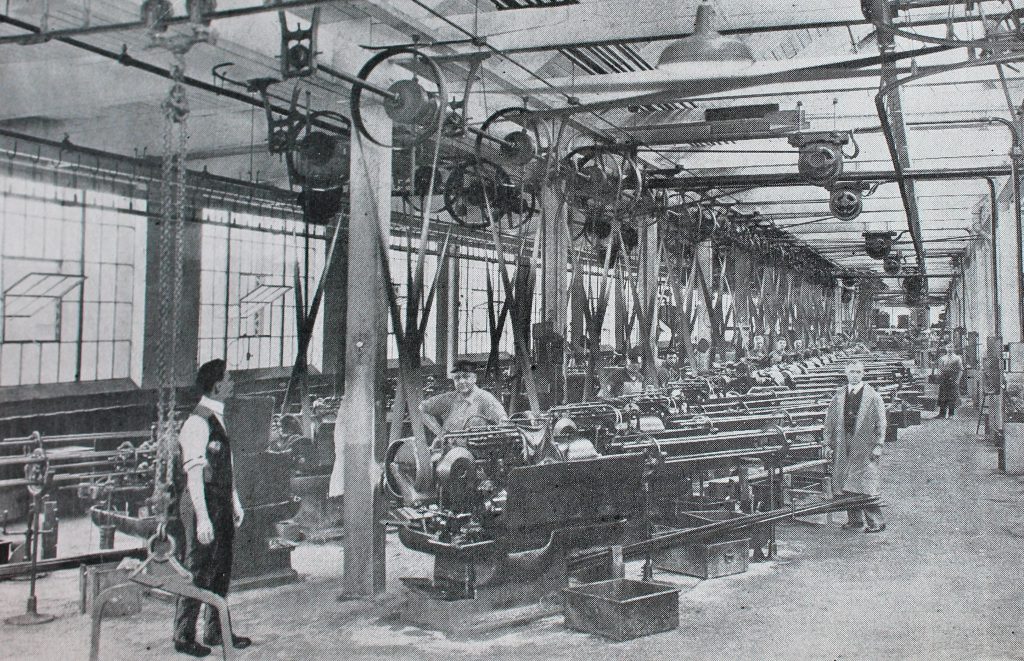
[Inside the Chicago Roller Skate plant on Lake Street, 1920s]
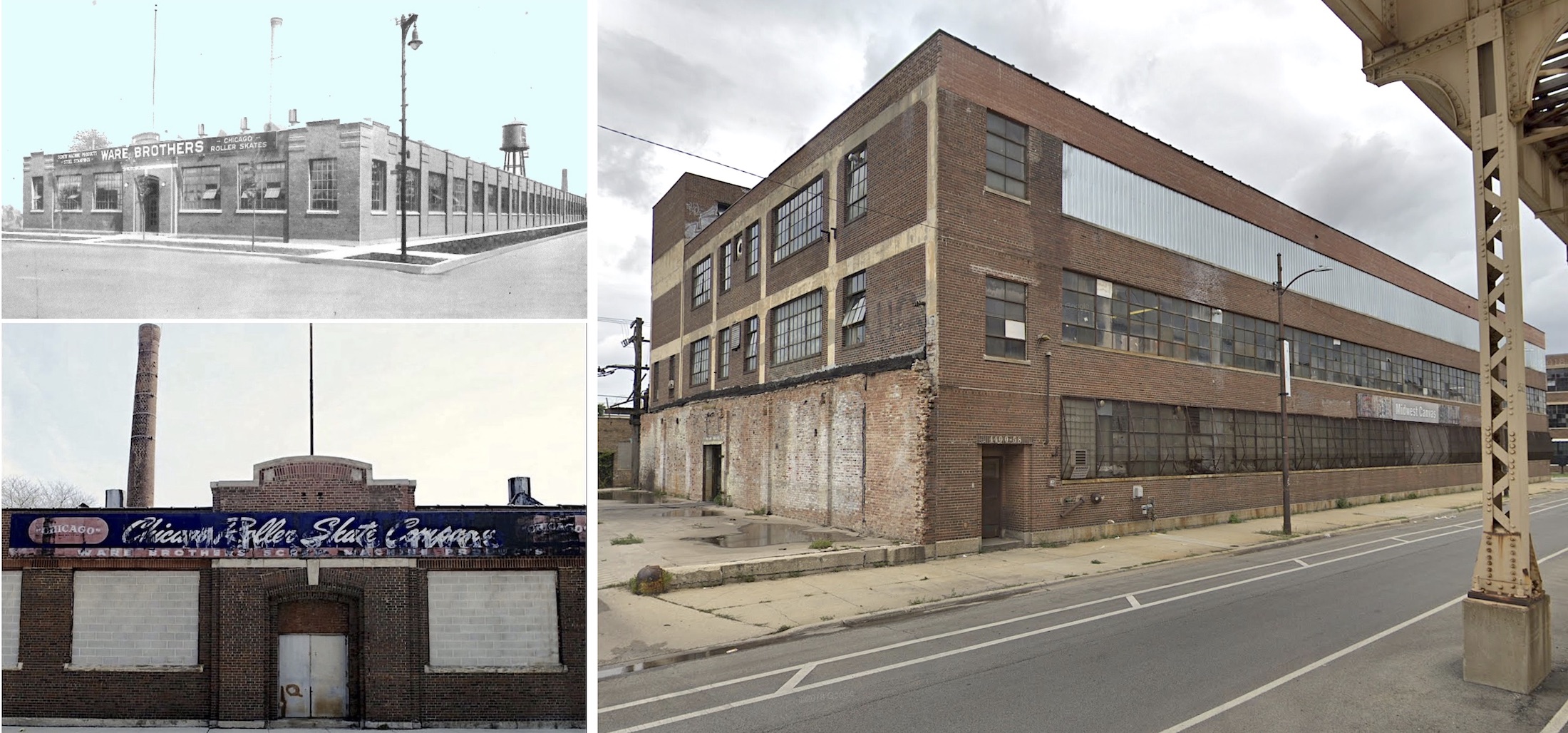 [Top Left: The original Ware Brothers / Chicago Roller Skate plant on W. Lake Street, 1930s. Bottom Left: The original Lake Street building in ruins in the early 2000s (it’s since been torn down). Right: The three-story expanded roller skate factory at 4400 W. Lake Street, which opened in 1939 and is still standing.]
[Top Left: The original Ware Brothers / Chicago Roller Skate plant on W. Lake Street, 1930s. Bottom Left: The original Lake Street building in ruins in the early 2000s (it’s since been torn down). Right: The three-story expanded roller skate factory at 4400 W. Lake Street, which opened in 1939 and is still standing.]
According to Ware, Jr., his father and uncles ran the business in a highly organized and ethical fashion, ensuring that no payroll was ever delayed even during the roughest days of the Depression. Part of their strategy included evenly breaking up their own management responsibilities. “Ralph, the oldest, was in charge of finances and the rink business,” Ware Jr. said. “Uncle Walter took care of the production of machined parts. My dad, Robert, supervised finishing operations such as plating, heat treat, and final assembly. They worked as a team and the company prospered as roller skating boomed again in the Thirties.”
Kids were still the company’s primary target demographic in the 1930s, but there was a widening world out there. Plenty of adults were skating by now, and many were treating it as a serious sport. The first big “Roller Derby” events were organized around this time and started drawing sellout crowds to major venues like the Chicago Coliseum. These were not the sorts of high-contact, hair-pulling derby matches popularized in the ’70s, mind you, but legitimate Olympic-style skate races stretched over several different events.
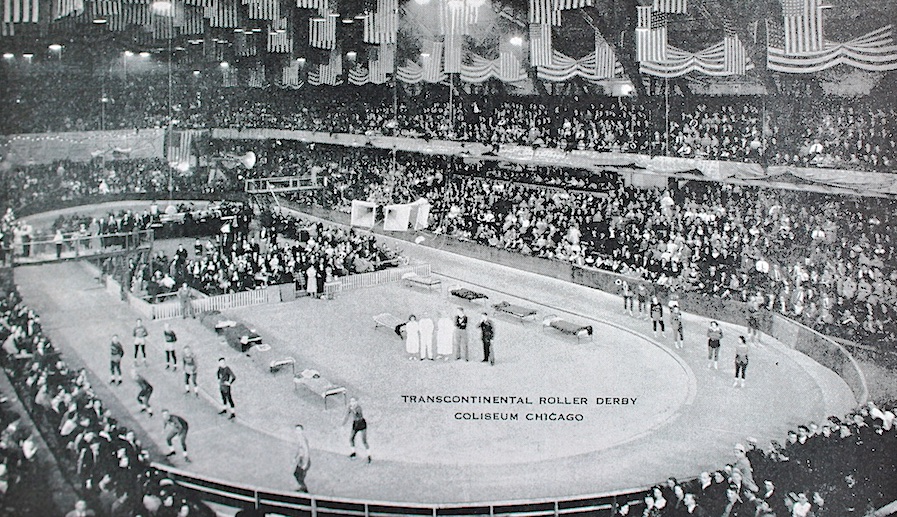 [Racing events like the 1935 Transcontinental Roller Derby at the Chicago Coliseum packed in very large crowds of spectators]
[Racing events like the 1935 Transcontinental Roller Derby at the Chicago Coliseum packed in very large crowds of spectators]
Chicago was a particularly good hub for the sport, as those thousands of spectators at local derby events often became quick converts and participants in their own right. For a city that had long been obsessed with ice skating in the cold winter months (major ice skate manufacturers like Planert and Nestor Johnson were based here), roller skating offered a way to carry the same type of liberating recreation into the summer—especially as the Chicago Roller Skate Co. started producing steel wheels with rubberized tires for safer outdoor skating.
Across the country, roller skating clubs were formed and countless rinks were opened to accommodate the growing sensation. Locally, many skaters flocked to places like Riverview Park, Arcadia Roller Rink, Madison Gardens, New Planet Roller Rink, and White City Roller Rink(the latter was technically named in honor of the 1893 Worlds Fair, but it was also picketed in the 1940s for its failure to welcome minority patrons, so the name may have had an unfortunate double meaning). The Ware Brothers came to lean on feedback from these venues in their own promotional materials, often publishing testimonials like the ones below, from a 1937 mailer.
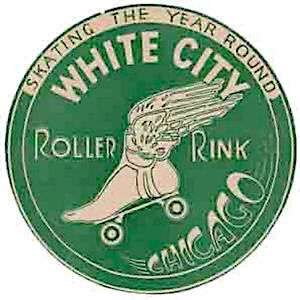 White City Roller Rink, Chicago:
White City Roller Rink, Chicago:
“Business has been very good with us this fall, and we are looking for still better crowds. …Your Skates are giving us good service, and we are well pleased with the prompt way you fill our orders. …White City opened in 1916 with 1500 pairs of CHICAGO Fibre Wheel Skates. At present we have 1150 pairs of CHICAGO Skates in the Skate Room besides 400 pairs owned by our patrons. …We wish to advise that your fibre wheels help keep our floor clean, and we appreciate the recent improvements you have made in your Skates, and will be very glad to recommend them to any Rink man as the most serviceable Roller Skate that we know of.” –Harry Palmer, Mgr.
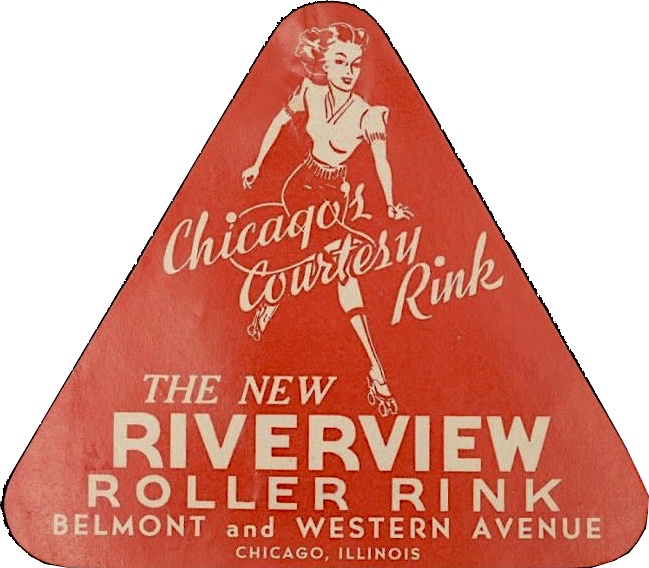 Riverview Roller Rink, Chicago:
Riverview Roller Rink, Chicago:
“As to the satisfaction of your Skates and service, we would advise that we are well pleased with both and want to thank you for the way you have always treated us. …It might be of interest for you to know that this Rink was equipped with 2,000 pairs of CHICAGO Roller Skates when it opened in 1907, and while some other makes of Skates were bought in following years, our equipment today consists of 1,000 pairs of CHICAGO Roller Skates. …I think they are the most satisfactory Skates for rink use, and am always glad to recommend them to anyone.” –E. Don Levy, Mgr.
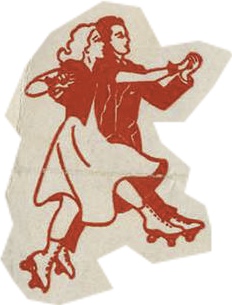 Casino Skating Rink, Prescot Rd., Liverpool, England:
Casino Skating Rink, Prescot Rd., Liverpool, England:
“Am very pleased to state the shipment of one thousand sets fibre wheels and grinder were packed excellently and received in excellent condition. I have tested the fibres out for the past five weeks, I surfaced the floor first, and I am astounded at the cleanliness of the floor after five weeks’ wear with approximately 30,000 skaters. They have given entire satisfaction and I would not think of going back to steel wheels at any price. ….Hoping you will let me know in good time when you visit England again, and that you are in the best of health.” –Arthur Lemni, Mgr.
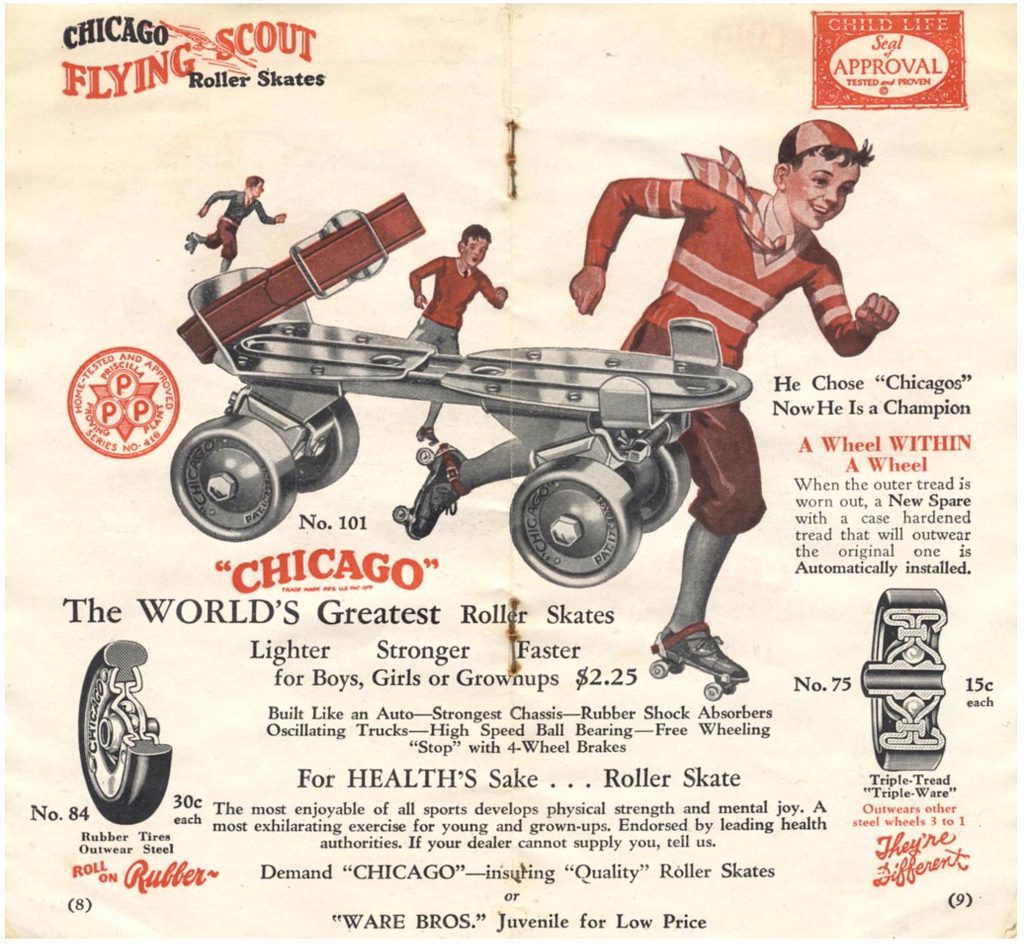 [1936 advertisement for Chicago Flying Scout Roller Skates]
[1936 advertisement for Chicago Flying Scout Roller Skates]
III. Peak Production
While the momentum of the ’30s was brought to a full stop in the ’40s by World War II, things never quieted down at the Ware Brothers’ Lake Street plant. About 450 workers were reporting there to work on defense contracts (mostly making M21 grenades, although a few skates were still produced for the amusement of the soldiers overseas) during the five year period when normal production was suspended. After the war, there were still some restrictions on materials for a while, but Chicago Roller Skate was mostly back to full power within a few years, albeit without one of the founding brothers, Ralph Ware, who died in 1945.
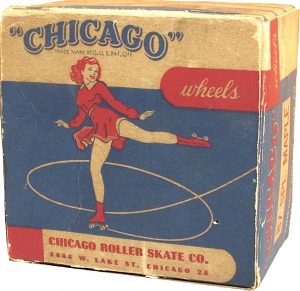 According to a 1952 feature story by venerable reporter Kermit Holt of the Chicago Tribune, the Chicago Roller Skate Co. had 200 employees churning out 3,250 pairs of skates per day—broken down into 1,500 pairs of outdoor/sidewalk skates, 1,000 rink skates, and 750 “shoe skate outfits.” With four wheels on each skate, that comes out to 26,000 wheels every day, in various diameters—some still made from the classic maple, others from steel, rubber, wood composition, fiber, plastic, or aluminum.
According to a 1952 feature story by venerable reporter Kermit Holt of the Chicago Tribune, the Chicago Roller Skate Co. had 200 employees churning out 3,250 pairs of skates per day—broken down into 1,500 pairs of outdoor/sidewalk skates, 1,000 rink skates, and 750 “shoe skate outfits.” With four wheels on each skate, that comes out to 26,000 wheels every day, in various diameters—some still made from the classic maple, others from steel, rubber, wood composition, fiber, plastic, or aluminum.
Of the 98 tiny parts that made up each individual post-war sidewalk skate, the Ware Brothers produced nearly all of them in-house, as well. They were now as much a hardware manufacturer as a roller skate business.
Inside the Chicago Roller Skate Factory: 1952
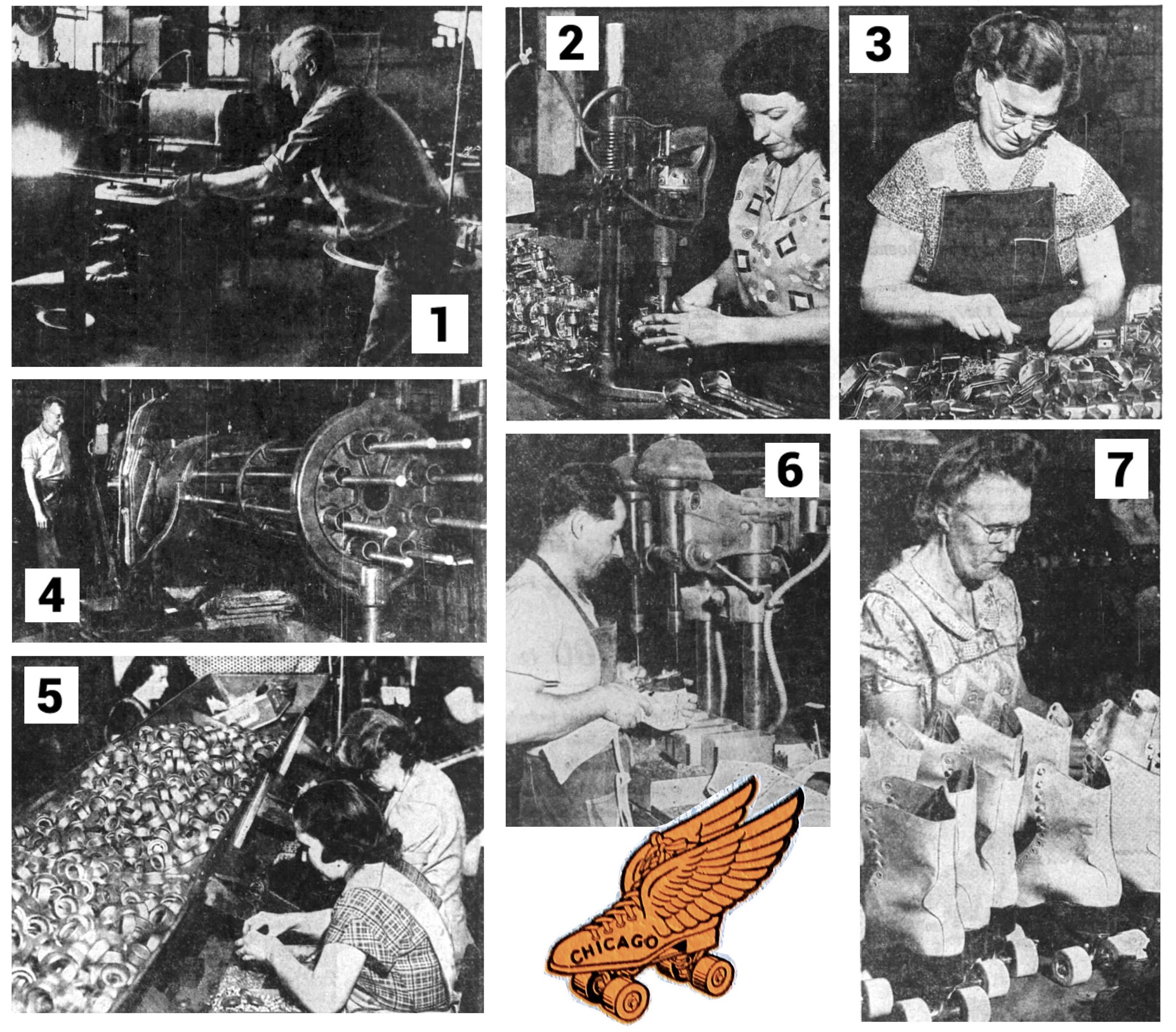 1. John Kowalski works on producing hard surface steel for the skates.
1. John Kowalski works on producing hard surface steel for the skates.
2. Sylvia Flanegan tightens fastenings for each skate.
3. Juanita Brown assembles hangers to the heel plates. The plates then move down a conveyer belt to a machine that rivets them together.
4. Brungo Migdal works a giant screw machine that produces roller skate wheels.
5. A group of women assemble wheels by hand. These models include three rivets and seven ball bearings.
6. Walter Michalski rivets skate chassis to shoes.
7. Stella West inspects and finishes a row of women’s shoe skates.
As the Chicago Roller Skate Company approached its 50th anniversary in 1955, they were arguably the leading ambassadors of a pastime that an estimated 20 million Americans participated in. Through their own careful marketing, they’d helped construct a vision of roller skating as a healthy, wholesome, family activity enjoyed equally by teens and their Communist-fearing parents. It was nearly a flawless execution of manufacturing + distribution + promotion.
[1950s promotional film produced by the Chicago Roller Skate Co. and Pepsi-Cola]
IV. Boards, Blades & Missed Opportunities
“The Chicago Roller Skate Company is entering the second half century of its operation with a management team that closely approximates the youth, energy, and forward look that stamped the Ware brothers, founders in 1905 of the company that they developed into the largest manufacturer of roller skates in the country.”–Billboard, January 1955
Chicago’s second generation of managers included Robert Ware Jr., Gordon K. Ware (son of Walter), and sales head Joe Shevelson, a former Air Force pilot with no family relation. The argument could easily be made that these gentlemen led the company to its best years, from the post-war ’50s to the roller rink revival of the ’70s. As mentioned in the introduction, though, there is an unavoidable “what if” quality to this same era, as the seeds for the future of sidewalk skating were being planted with Chicago somewhat frustratingly on the periphery.
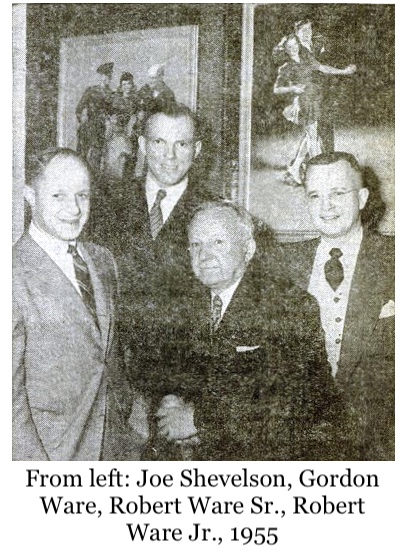 In fairness, the company was actually the first skateboard parts supplier in America in 1962, when it reached a deal to sell the axle-holding trucks and wheels from its roller skates to a Hollywood surf shop called Val Surf, the pioneering business of standardized skateboard production (before that, kids were still fashioning makeshift boards by attaching dismantled roller skates to warped planks). Former Val Surf president Mark Richards later recalled that “Chicago wasn’t too hot on the idea” of selling their parts for this new venture, but reluctantly agreed.
In fairness, the company was actually the first skateboard parts supplier in America in 1962, when it reached a deal to sell the axle-holding trucks and wheels from its roller skates to a Hollywood surf shop called Val Surf, the pioneering business of standardized skateboard production (before that, kids were still fashioning makeshift boards by attaching dismantled roller skates to warped planks). Former Val Surf president Mark Richards later recalled that “Chicago wasn’t too hot on the idea” of selling their parts for this new venture, but reluctantly agreed.
There is some evidence that Chicago Roller Skate might have briefly produced its own line of complete skateboards in the mid 1960s, as you’ll occasionally find “Chicago” branded wooden boards in vintage collections. It seems more likely, though, that the actual deck portions of those units were either made by another company or home-made by skaters, and that any attached “Chicago” stickers probably just came with their wheel assembly kits. Either way, the Wares never seemed eager to fully embrace the sidewalk surfing revolution, seeing it as more of a dangerous fad than a true threat to the purity of roller skating.
“I’m happy we stayed out of the business,” company president Gordon Ware told the Tribune in 1977, “because 128 of the 130 firms making skateboards went broke.”
His brother Robert went a step further, claiming in 1979 that, “The death wish of youth—skateboards—is now being eliminated for a more adult, safe and less exerting activity.”
Okay, so the Wares may have misread their tea leaves when it came to the skateboard, but their track record shows they were more than happy to ponder other progressive concepts. In fact, Gordon Ware personally designed one of the first hockey-style / in-line roller skates, patented in 1966. . . . Unfortunately, the concept was deemed too far ahead of its time, and was swiftly discontinued. In the short term, the consequences were minimal, as the company cashed in during the disco era selling record numbers of its traditional skates: two-in-the-front, two-in-the-back, too cool for school.
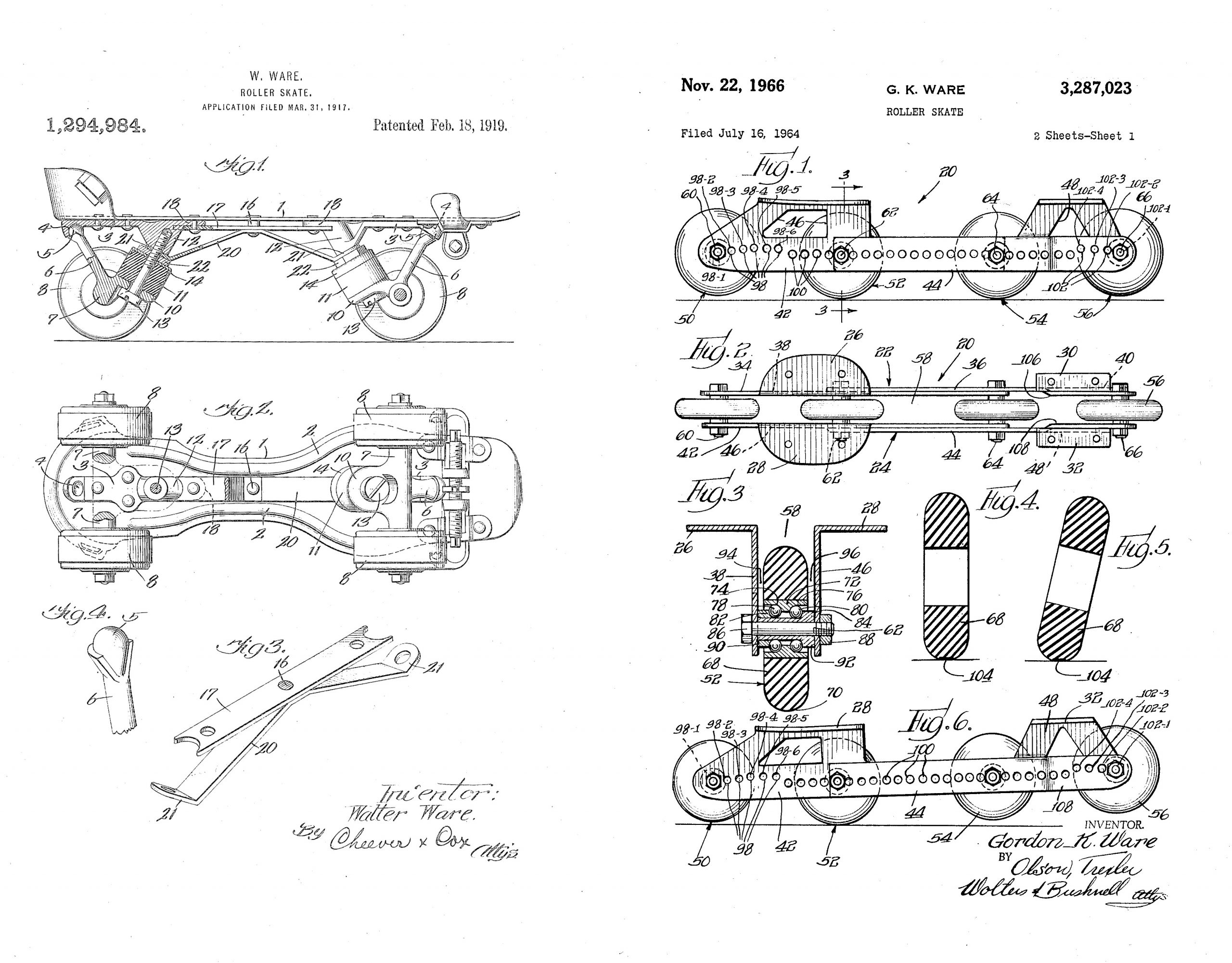 [Left: A Walter Ware skate design patent from 1919. Right: His son Gordon Ware’s innovative in-line roller skate design, patented in 1966; about 30 years before the Rollerblade’s heyday]
[Left: A Walter Ware skate design patent from 1919. Right: His son Gordon Ware’s innovative in-line roller skate design, patented in 1966; about 30 years before the Rollerblade’s heyday]
It was around the end of that groovy era, however, in 1979, that the long-forgotten single-line skate design suddenly became relevant again. Up north in Minneapolis, a teenage hockey player named Scott Olson stumbled upon Gordon Ware’s 1966 patent while working on developing his own version of a street hockey inline skate. Olson knew he’d need to get licensing rights from the Wares in order to carry forward with his work, and in 1981, he hitchhiked to Chicago and successfully did just that, with little pushback from a bemused team at the Chicago Roller Skate offices.
Oops.
[Scott Olson, “inventor” of the inline skate, in 1982]
Olson’s product, the Rollerblade, would eventually be sold to every teenager living in a town where summer exists. By contrast, the once mighty Chicago Roller Skate Company would see its profits dwindle, forcing a sell-off to the National Sporting Goods Company in the 1990s—thus ending the legitimate Chicago era of the “Chicago” brand.
The Lake Street factory remained in business into the 1980s, when the company’s fortunes—like so many other once-mighty industry leaders of the mid-century—took a downward turn. If they’d told Scott Olson to get lost and go skate off a bridge, perhaps the third and fourth generation of the Ware family would have enjoyed the spoils of the “Rollerblade Years.” Nonetheless, a 90-year run is nothing to sneeze at. In roller-skating, as in life, we all will inevitably fall on our butts at some point. It’s the proverbial journey that speaks more to Chicago Roller Skate’s lasting cultural significance than its endpoint.
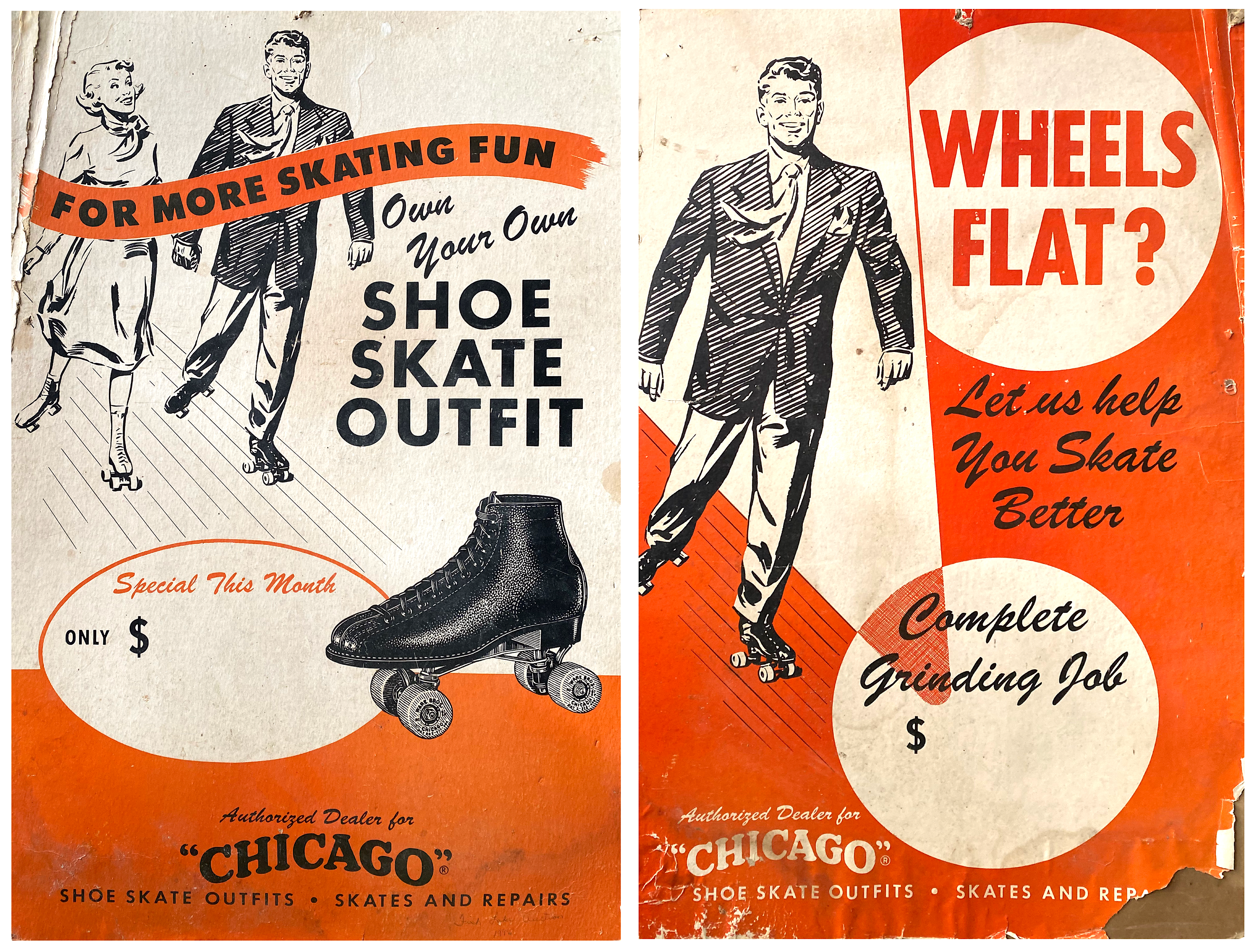
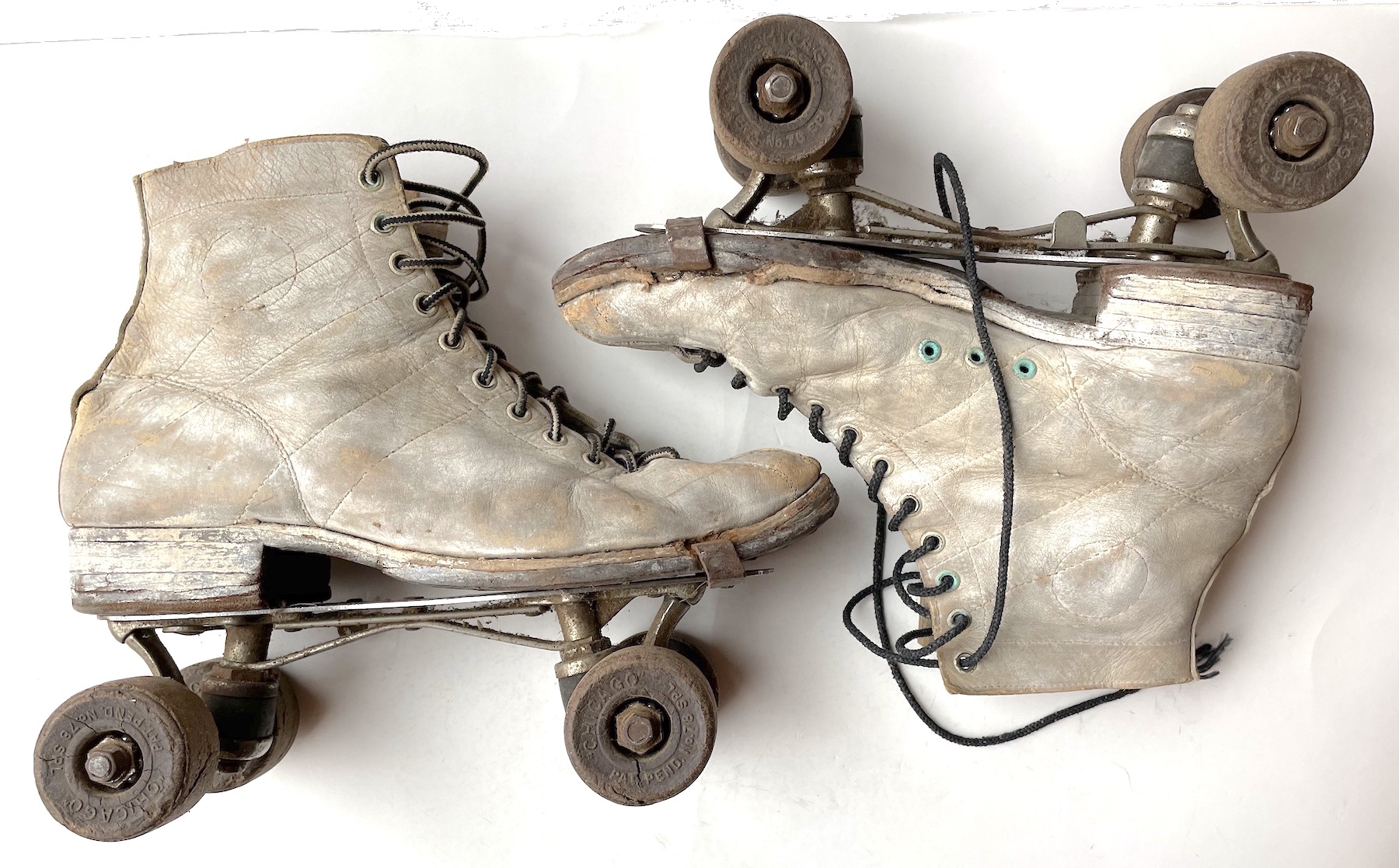
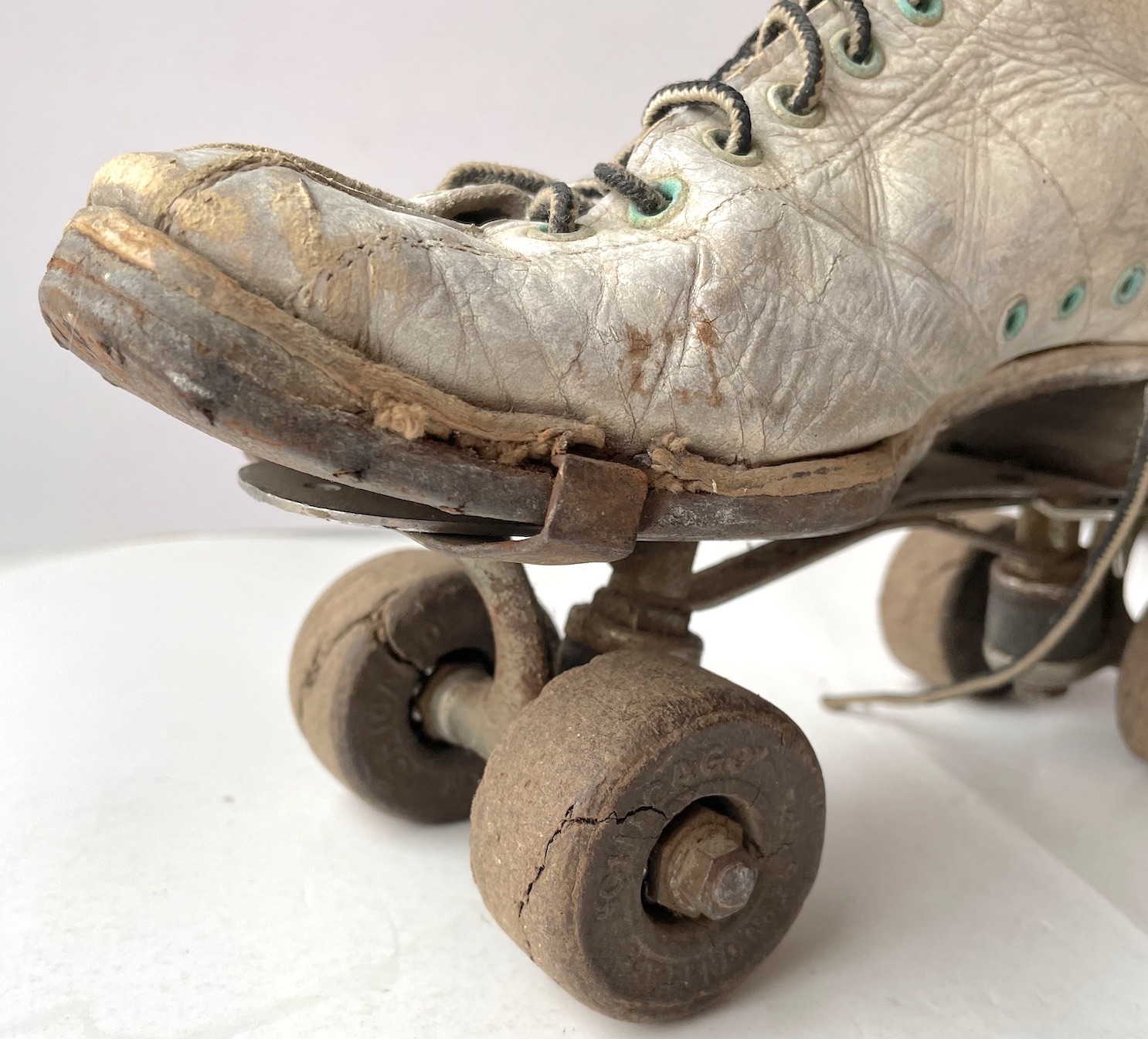
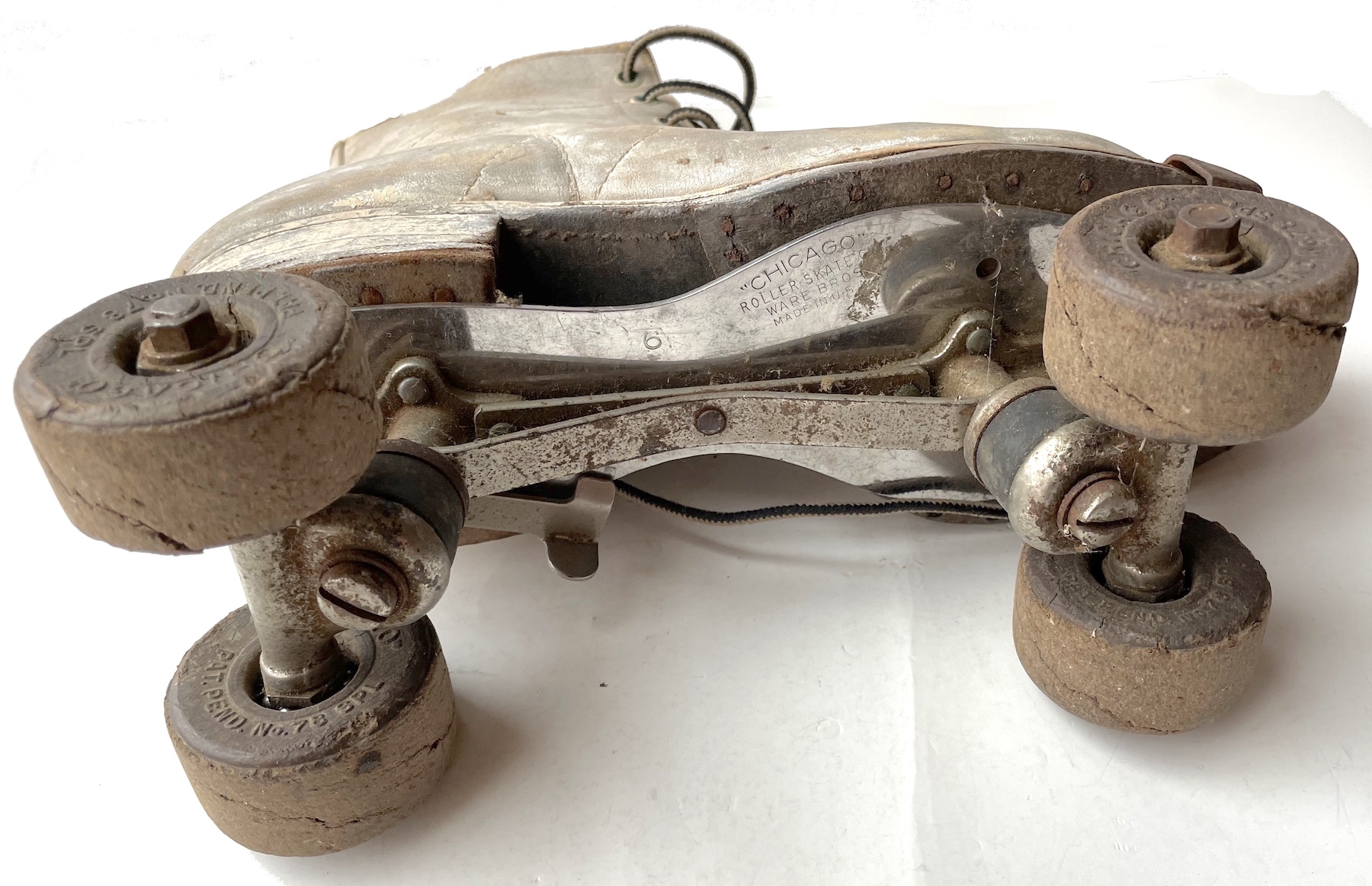
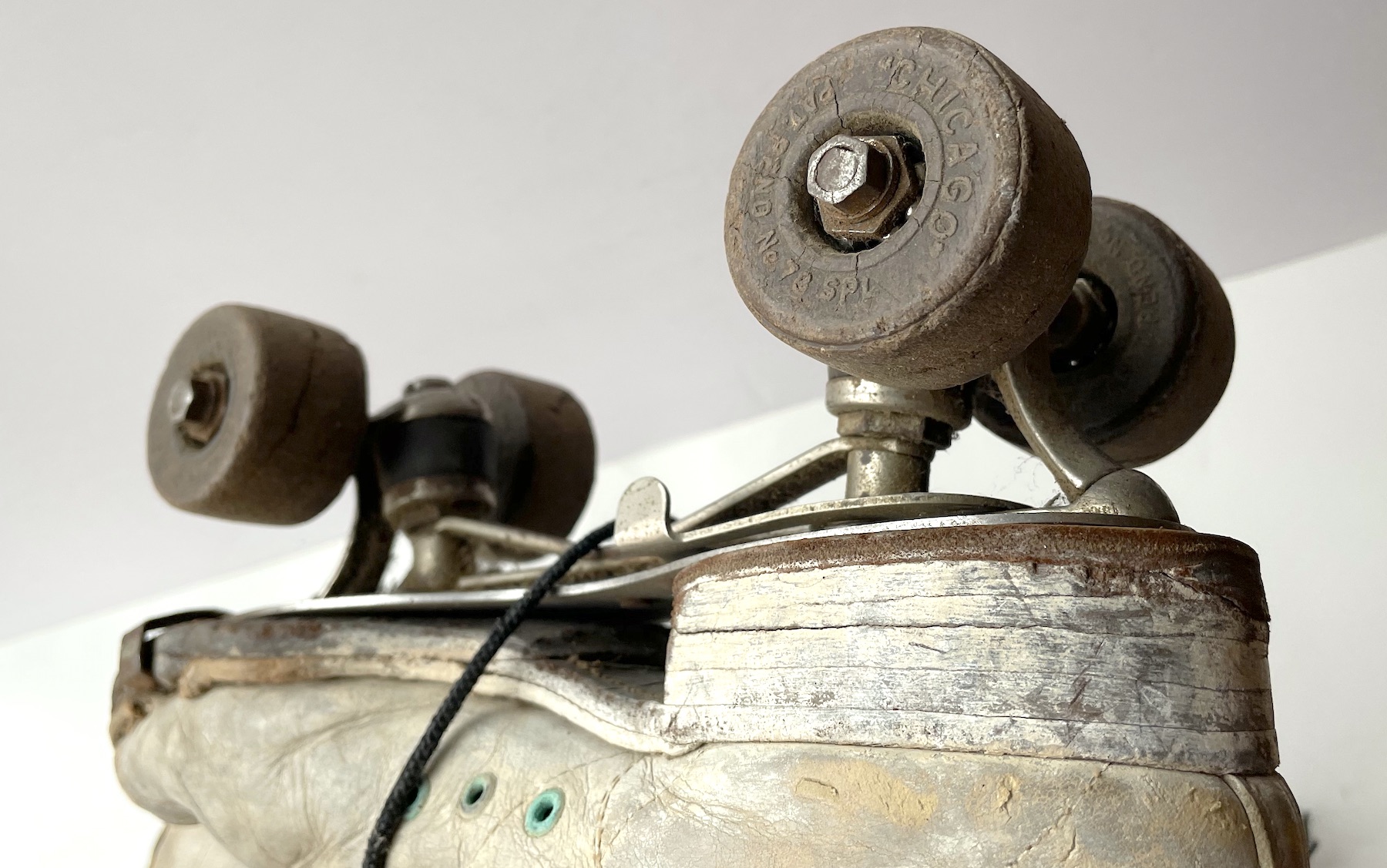
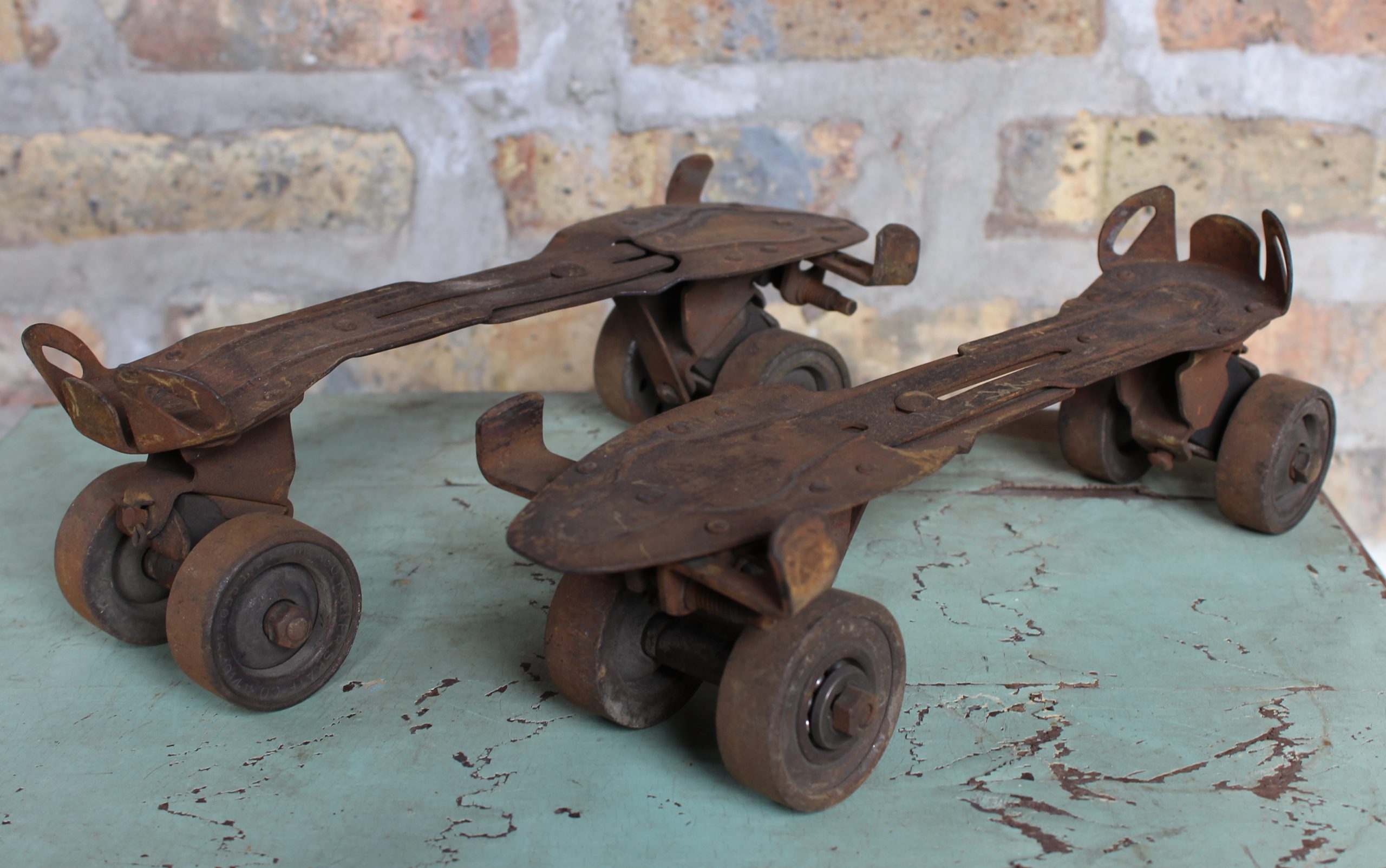
[This set of bootless Chicago Roller Skates, circa 1920s, is also part of our museum collection. The wheels feature a patent date of 1914]
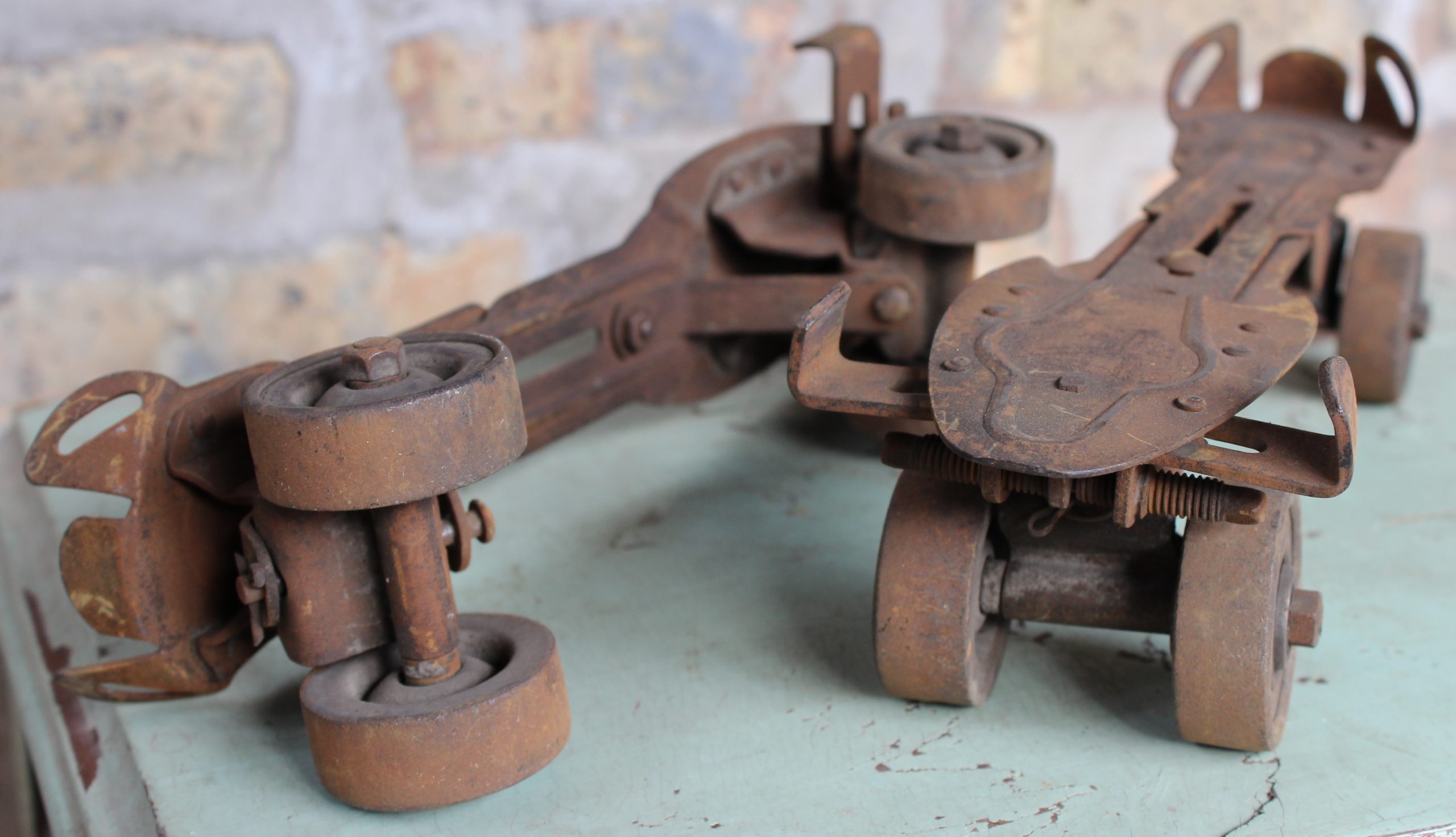
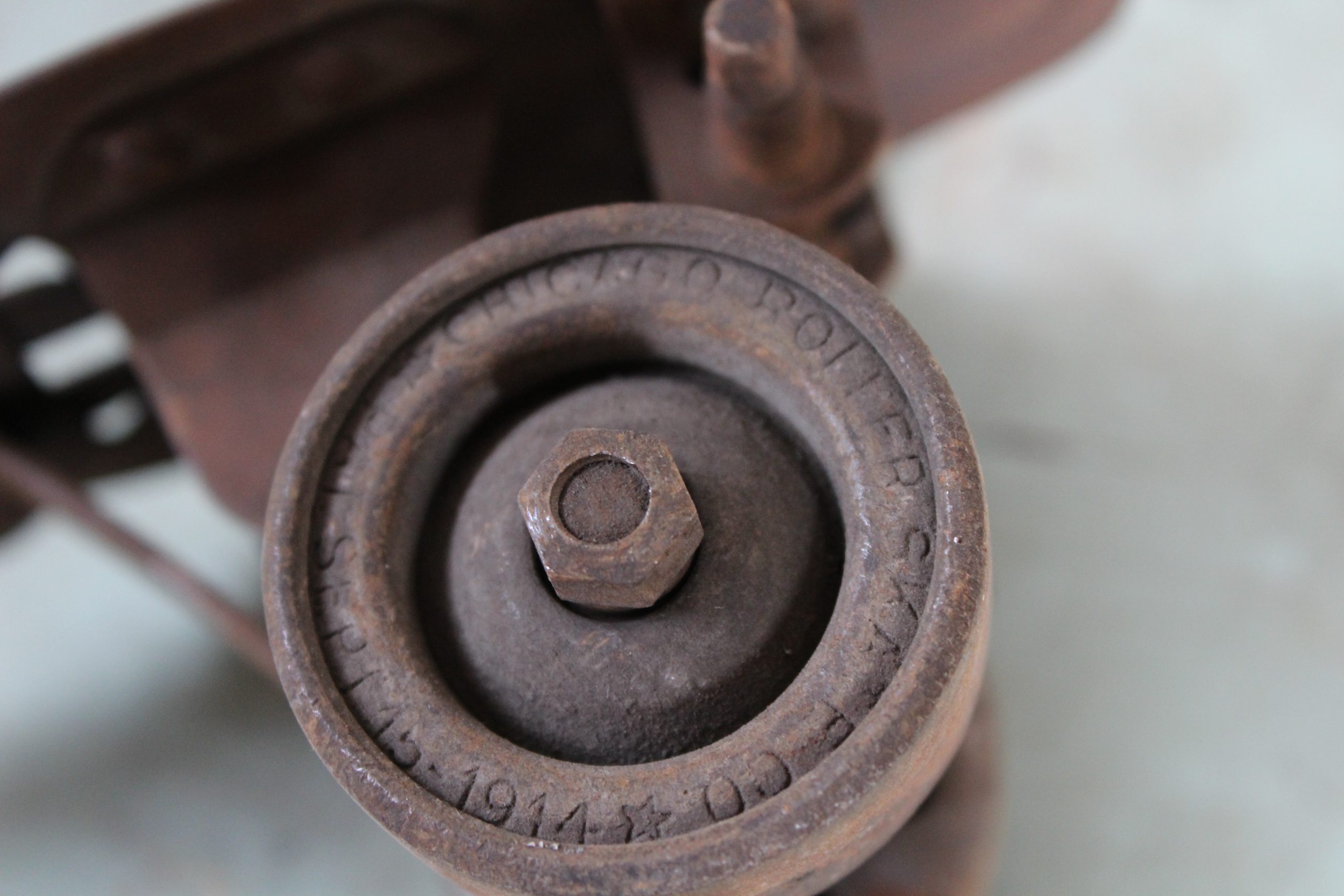
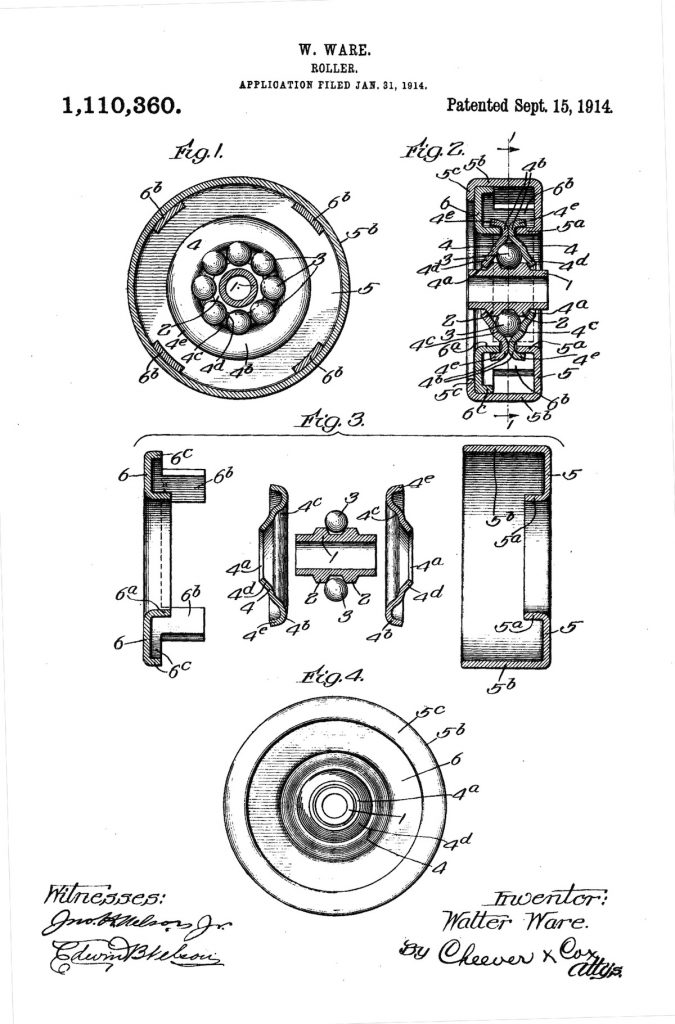
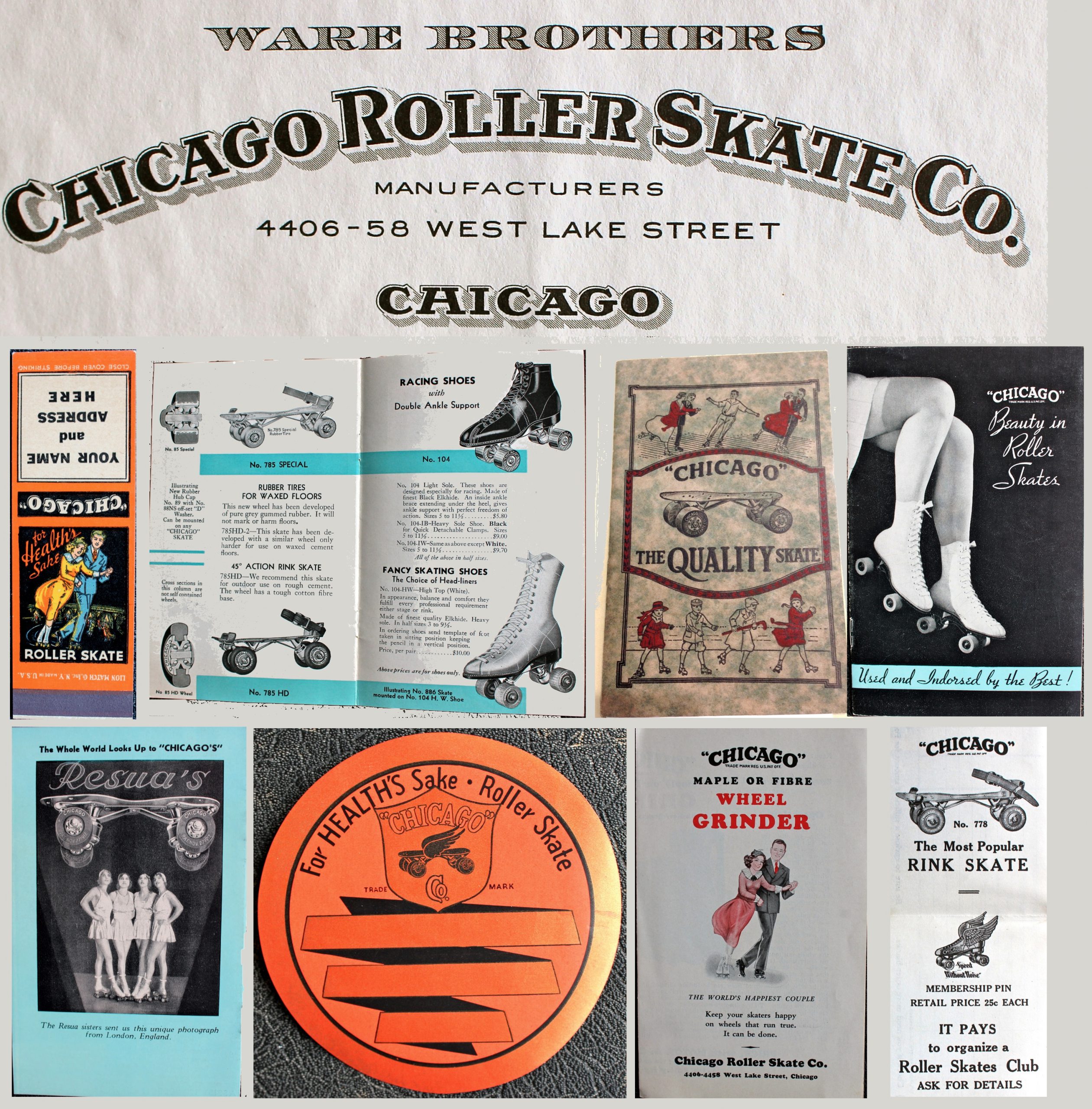 [Various Chicago Roller Skate Co. ephemera from our own museum collection]
[Various Chicago Roller Skate Co. ephemera from our own museum collection]
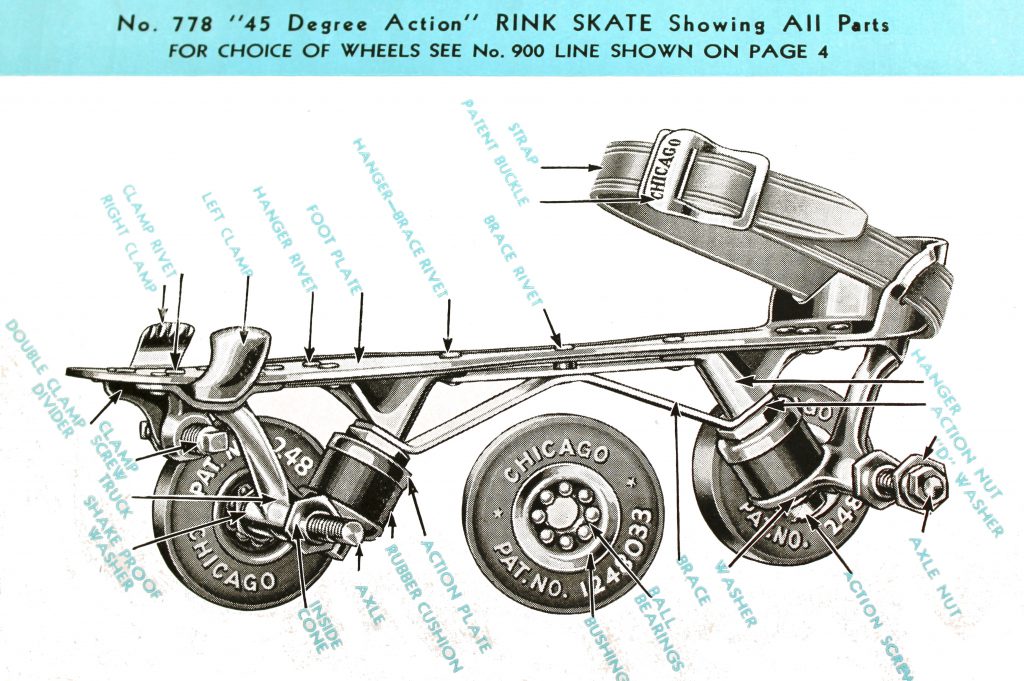
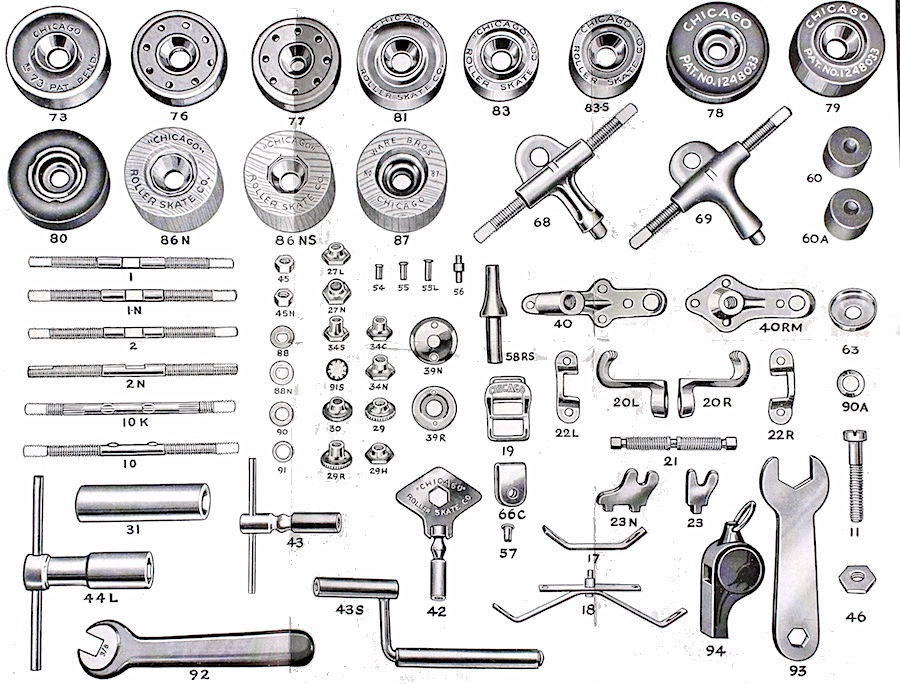
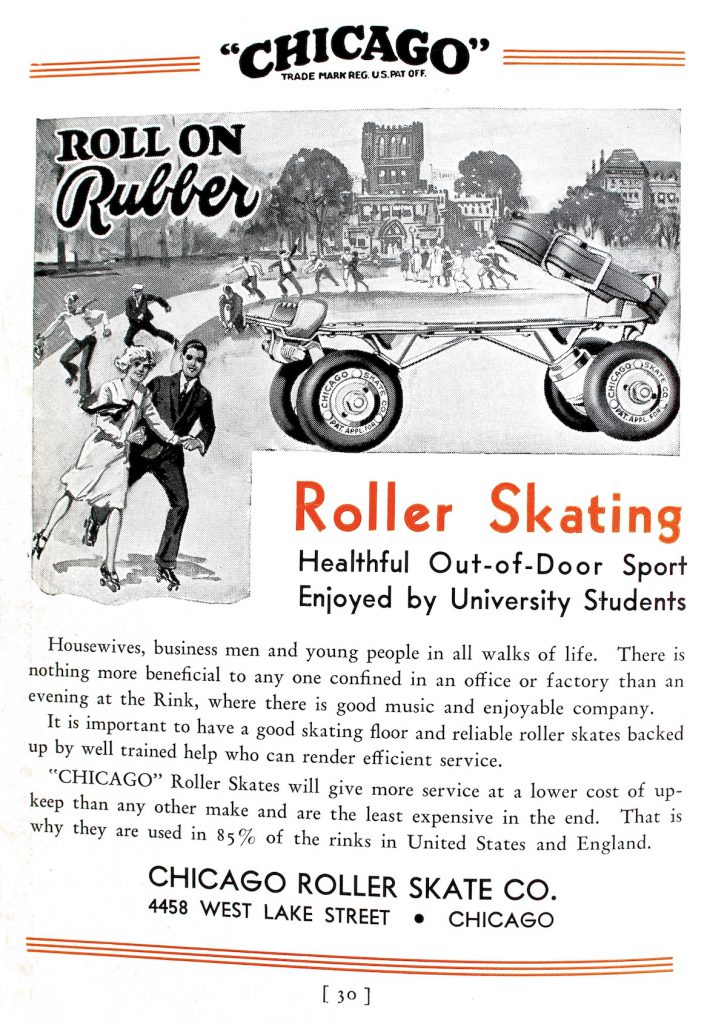
SOURCES:
“Roller Skating Survives, Comes Back to Life” – Salt Lake Tribune, March 26, 1977
“Birds on Wing; Kids on Wheels; Sure, It’s Spring” – Chicago Tribune, April 10, 1952
The Skateboard Book, by Ben Davidson, 1976
“Able, Energetic Team Heads Chicago Skate” – Billboard, Jan 22, 1955
“Rolling Along with a Fad” – Philadelphia Inquirer, Nov 18, 1979
“Rollerblade Pioneer Scott Olson Reinvents the Wheel” – City Pages, Nov. 21, 2012
Rolling Through Time: Official Newsletter of National Museum of Roller Skating, December 1, 2015
“Chicago Roller Skates” – Hardware Dealers Magazine, Vol. 56, 1921
Archived Reader Comments:
“I still skate on Chicago GM II plates. I have 3 sets of them. Best skates made.” —Roy, 2019

I have a light up sign that I acquired, when the roller rink I worked at, closed in the early 80’s. It says, “Buy Here from an Expert, Chicago Custom Skates, sold only by rinks”. There is a label on the back that says it was made in Chicago by Plastiform Corporation on West Fullerton Ave. It still lights up and is in good shape. I was wondering if anyone had any information on this sign, such as when Plastiform was in existence? Were there many of these signs made? Did they make signs for other companies? I can’t find anything about them. I don’t know if it has any value, but it reminds me of my younger days and my love skating.
I was looking through my grandfathers old things and I found an almost like start hexagon key. It says “Chicago roller skate co” what was this used for and what is it worth?
In approximately 1972-73 ( maybe earlier ) my friends and I were on the box used for the street hockey skates. It was a dot print not a photo be we all knew that it was us. One of the players father worked for JC Penny as a shoe buyer. He got us hooked up with Chicago skates. We tested new boots, wheels, carriages, etc. That’s when there marketing dept to pictures of us playing hockey and used our image on the box cover. There’s only a few us still with us today but we were wondering if you could help us get a copy of the box cover with our image. Thank You
I have a pair of Chicago “Futura” plates in good condition .Purchased in 1965 .Can anyone give me a value for them.They’re on Riedell or Hyde boots size 11-11 1/2.Platinum precision wheels
I have a very nice set of no.181 silent flash skates in the original box. They are nearly ” unused” in condition. I’m Having trouble nailing down the production date. The skates have Pat# 1,910,193 on the top plate. Can anyone help on a potential manufacture date?
What does the number 800 means on my roller skates?
Hi I have a pair of Chicago of Chicago custom roller skate Co skates I would be willing to entertain what they may be worth. Very good condition. And definitely all original. Thanks I loved the article. The America that I was raised in was what I wish it could have stayed but I’m soap boxing now.
I am now 61 years old and I have been back on the wood now for 6 years after a 22 year hiatus
I was lucky enough to find a used Hyde boot but later found that Chicago skate company was the manufacturer of the Panther plate which has disappeared from existence and my friends and I are trying to get any help and information on the possibility of maybe getting hold of old stock or if anyone is willing to explore maybe custom fabrication
Ive got a pair of roller skates from 1905. Whats their worth if i was to sell them?
I have VINTAGE CHICAGO ROLLER SKATES WOMAN’S 4 WOOD WHEELS WARE BROS NO 87 SP 2-333-400 the stamped underside says patent 1914 and they have Pom poms on the laces and pro-tec-toe’s any way to date them? I’m looking to sell them
My skates say 1914 on the skate are they worth anything
I am looking to purchase pivot rubbers and cushions for starfire 500 roller skates, I live in Adelaide south Australia, can you help
I own a pair of chicago roller skates that I have skated on since 1971. I’m 68 years old and skate at Robben’s Roost Skating Rink in Louisville, Kentucky. We really roll in the “VILLE”!!! Can I get information with Pat. No.3 180 651 for my personal history. And how rare for these Skates over 50 years old still being used. Thank You.
I have an old 1950’a wheel grinder from our rink. Labeled Chicago Roller Skates. Are you interested? I have pictures. Pretty cool with numbers on label.
Marcia Goodrich-Volker
Hi Marcia, can you email photos of the grinder to contact@madeinchicagomuseum.com ? We can take a look and discuss further. –Curator, Made In Chicago Museum
I’m interested in purchasing
Can I see pictures please 🙂
I’m looking to find out where I can get a whole set of skates to stock a roller rink. Just shopping around to find out where I can get them for the right price to open a rink..
Where can I buy a set of urethane wheels for the 1950’s model 1087 GBF Velvet Tread? It currently has number 87 Maple wheels on it.
Wow amigo, ya encontraste su valor para venta?
Hello I have A pair of Chicago men’s special black rollerskates number 505MS in the box that say these shoes were made exclusively for Johnny Jones and I was wondering if someone could help me find the value because I can’t find anything like them
Does the museum have any memorabilia of couples competitive skating?
I have some roller skaters from the 70s have much their worth, ist in original box and they are boots.
I have a pair of Betty Little high top leather boot quad skates and have had them since the 60’s they have a solid bar for the trucks the only thing I can find is: 7 2/3 pat # 8.156.482 stamped on the bar any info would help.
I have product number 5-5518 velvet tred, white skates, red box. Decent condition. Patton number 1248033 on wheels, all original, flat mee on wheels has Chicago warebros or warriors. Can u tell me if they are worth anything and if so, where and how to sale. Thanks
Saw this on Amazon:
Sure-Grip Factory OEM Wood Wheels
Maybe that’ll help.
Can anyone help me find out anything about the 87 spl maple Chicago roller skate wheels
I have a metal pin with a skateboard that has wings on it. Did Chicago happen to make any advertising items for their skateboards like the winged roller skate? Thanks in advance.
my wife recently purchased a pair of skates from an estate sale that says Chicago skates dated on tongue of 1914 with maple wheels all original and mint condition. simply beautiful.
How can i determine how old a pair of skates is?
Hi, i have a little giant, floor model skate wheel grinder from i beleive the early 50s, wondering what it might be worth, it does work great, thanks for any info
Con you tell me when my skates were manufactured?
The serial Number on the skate itself is 1910193
The wheels have a number 1790293
Do you know where I can purchase new leather straps?
Hi we have orginal 1914 detachable skates with black boots and case.
Havent seen anything like these before and I have searched and searched.
What would they be worth please?
Im located in australia
I have a bench grinder with a metal manufacturing plate and it says it’s from this company. Would this be something that was produced by them? Really confused why I can’t find any information. Please help !
I am looking for 6 buckles for Chicago Skates that appear to be from the 1920’s. We are trying to set up an exhibit at the Arts and Heritage Center in North Augusta, SC and have some skates but the buckles are missing and/or very rusted. I have replacement strapping for the skates.
I bought a pair of old skates. The patent #1922609. Can you give me any information about when they were made.
I recently found a pair of white ladies size 8 1/2 chicago roller skates. They were in a case so they are use but in very good condition. I wonder if you can help me date them. On the bottom near the front they are stamped, Chicago rollerskate co. Ware bros. Made in USA. No date that I can find. The wheels read. Chicago Pat. No.1248033. Can you help me at all with dating these skates?
I have a box of wood roller skate wheels. In original box and never used. Just wondering they are worth?